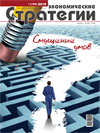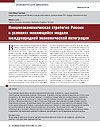Russia’s Foreign Economic Strategy in the Context of a Changing Model of International Economic Integration
Existing model of international economic integration faces a number of limitations impeding further development of globalization. Using the example of the US metallurgical industry, the article shows that globalization can cause negative consequences for the developed countries economies, including the erosion of national security. The work notes the presence of a discrepancy between the target and ideological purposes of the “Foreign Economic Strategy of the Russian Federation” and the changed external conditions for the national economy development. Normalization of the imports presence in the domestic market is a necessary step towards diversifying the economy and increasing non-commodity exports. In the new model of international trade, which is formed on the basis of China’s foreign economic relations, Russia may occupy a niche of infrastructure solutions supplier in the field of energy, technologies of natural resources extraction, as well as military equipment and weapons to ensure the sovereignty of countries that extract and export natural resources.
References:
- The Effect of Imports of Steel on the National Security. U.S. Department of Commerce, 2018, January, 11, available at: https://www.commerce.gov/file/effect-imports-steel-national-security-investigation-conducted-under-section-232-trade.
- Vneshneekonomicheskaya strategiya Rossiiskoi Federatsii do 2020 goda [Foreign Economic Strategy of the Russian Federation Until 2020]. Sait Soveta po razvitiyu vneshnei torgovli i mezhdunarodnykh ekonomicheskikh otnoshenii, available at: https://www.rtedc.org/docs/Vneshneekonomicheskaya%20strategiya%20RF.pdf.
- Gusev M.S. Importozameshchenie kak strategiya ekonomicheskogo razvitiya [Import Substitution as Economic Development Strategy]. Problemy prognozirovaniya, 2016, no 2, pp. 30–43.
- Strukturno-investitsionnaya politika v tselyakh obespecheniya ekonomicheskogo rosta v Rossii [Structural-Investment Policy for Providing Economic Growth in Russia]. Pod nauch. red. akad. V.V. Ivantera. Moscow, Nauchnyi konsul’tant, 2017, 196 p.
- Hurley J., Morris S., Portelance G. Examining the Debt Implications of the Belt and Road Initiative from a Policy Perspective. Center for Global Development, available at: https://www.cgdev.org/sites/default/files/examining-debt-implications-belt-and-road-initiative-policy-perspective.pdf.
- Apokin A.Yu., Belousov D.R., Sal’nikov V.A., Frolov I.E. Dolgosrochnye sotsial’no-ekonomicheskie vyzovy dlya Rossii i vostrebovannost’ novykh tekhnologii [Long-term Socio-Economic Challenges for Russia and the Demand for New Technologies]. Forsait, 2015, no 4, pp. 6–17.



